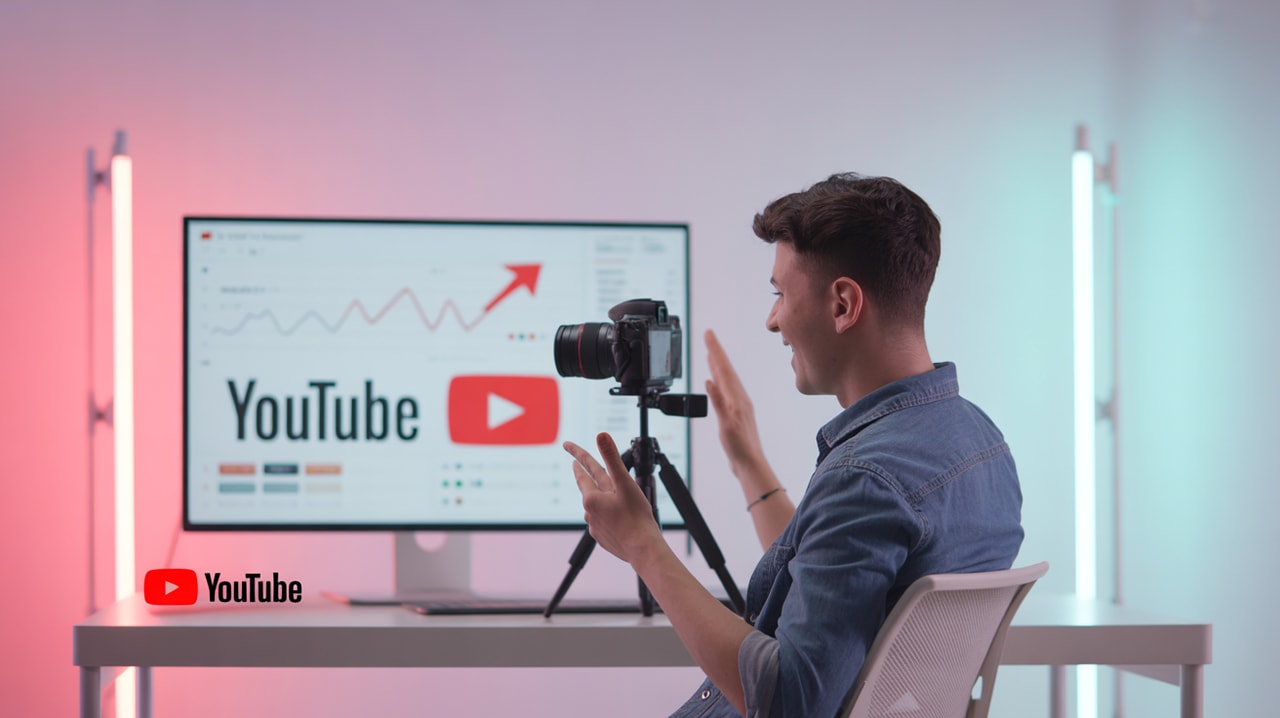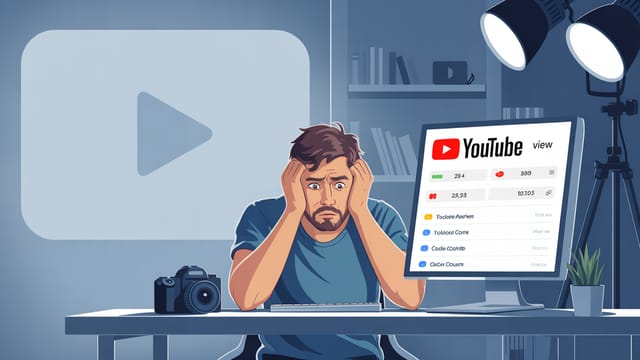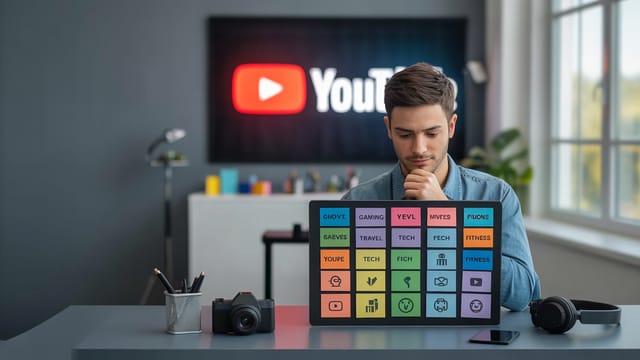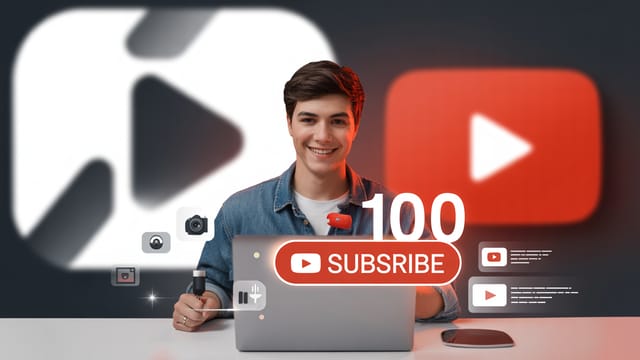
Ready to get your next 10,000 subscribers?
Join thousands of creators who use Subscribr to create faster, better YouTube videos.
<title>Fundamental Strategies for Growing a YouTube Channel From Scratch</title>
<category>YouTube Strategy</category>
<subcategory>YouTube SEO & Ideation</subcategory>
<meta_description>Starting a YouTube channel and want to grow? Learn the fundamental strategies, from niche selection and content planning to SEO and promotion, for success.</meta_description>
Starting a YouTube channel can feel like shouting into the void. You pour hours into creating videos, upload them, and... crickets. It's a common pain point for new creators: difficulty getting videos discovered, uncertainty about how to reach the right audience, and the constant struggle to come up with fresh, engaging ideas that actually get views and subscribers.
But here's the good news: You don't need luck or a viral miracle to grow. There are fundamental strategies that successful creators use, and you can too, even starting from zero. This guide will walk you through the core principles to build a solid foundation for your channel's growth.
## Laying the Foundation: Niche, Audience, and Value
Before you even hit record, the most critical steps are defining *who* you're making videos for and *why* they should watch you.
### Finding Your Niche
Many new creators make the mistake of trying to make videos for everyone. This rarely works. To grow from scratch, you need to find your specific corner of YouTube – your niche.
Think about what you're passionate about and what skills or knowledge you have. Then, consider how that intersects with what people are actually looking for on YouTube. Your niche should be specific enough to attract a dedicated audience but broad enough to offer plenty of content opportunities.
Instead of just "cooking," maybe it's "beginner vegan meal prep for busy professionals." Instead of "gaming," perhaps it's "retro RPG reviews for nostalgic gamers."
As the YouTube strategy experts point out, identify what you are proficient at and passionate about, and crucially, how you can use those skills to *help* others.
### Understanding Your Target Audience
Once you have a potential niche, dive deep into who your ideal viewer is. What are their interests? What problems are they trying to solve? What questions are they asking?
People primarily come to YouTube looking for solutions, education, or entertainment that speaks directly to them. Your content needs to address their specific pain points. For example, if you're in the fitness niche, instead of a generic "How to Get Fit" video, focus on a specific problem like "How to build muscle with just bodyweight exercises at home" for someone who can't go to the gym.
Gathering audience feedback is invaluable here. Talk to potential viewers – friends, family, or online communities related to your niche. Ask them what they struggle with and, importantly, **what they would type into the YouTube search bar** to find help. Their answers are gold mines for video ideas and titles.
Tools like Subscribr's Audience Persona generation can help you visualize your target demographic and understand their needs based on channel data and content analysis.
## Content Strategy: What to Make and Why It Matters
With your niche and audience defined, it's time to think about the content itself. What types of videos will you create, and how will you ensure they resonate?
### Ideation Techniques That Work
Struggling to consistently generate engaging video ideas is a major hurdle for beginners. Generic ideas won't cut through the noise. Your ideas need to be targeted and validated.
Focus on solving the problems your target audience faces. Brainstorm specific questions related to your niche and turn them into video topics. Look at successful channels in your niche (but don't just copy!). Analyze what types of videos performed well for them.
The strategy experts suggest iterating on different formats and concepts early on. Try 30 different concepts within your first 30 days to see what resonates with your audience and what you enjoy creating. Once you find something that works, double down on it while continuing to experiment.
Subscribr's Niche & Video Ideation tools can analyze successful channels and break down viral video structures to help you research and validate your next video idea.
### Building Topic Authority
YouTube's algorithm rewards channels that demonstrate authority on a topic. This means consistently creating high-quality content around your niche. Don't jump between wildly different subjects when you're starting out. Stick to your defined niche to build credibility with both viewers and the algorithm.
Over time, as you cover various aspects of your niche, you'll establish yourself as a go-to resource.
## Getting Discovered: Modern YouTube Optimization
This is where many beginners get stuck, often focusing on outdated "keyword stuffing." YouTube's algorithm is far more sophisticated now. It's less about keyword density and more about understanding searcher intent and providing a great viewer experience.
### Beyond Keywords: Focus on Searcher Intent
Instead of just finding keywords and stuffing them everywhere, think about *why* someone is searching for a particular phrase. What problem are they trying to solve? What information are they seeking? Your video needs to be the best possible answer to that search query.
While [traditional keyword tools](/p/youtube-keyword-research-ultimate-guide) aren't the focus of modern YouTube SEO, understanding the language your audience uses is still crucial. Use the insights you gained from audience feedback (what they would type into the search bar) to inform your titles, descriptions, and even the language you use in your video.
### Crafting Compelling Titles and Thumbnails
Your title and thumbnail are your video's first impression. They are critical for getting clicks when your video appears in search results or as a suggested video. They need to be clear, intriguing, and accurately represent your video's content.
Study successful videos in your niche (like those found via `youtube_video_search` about starting a channel, which have view counts ranging from thousands to millions). Notice how their titles pique curiosity and their thumbnails are visually striking and easy to understand at a glance.
For example, a video titled "How to Start a YouTube Channel for Beginners (Step-by-Step Tutorial)" by [@ThinkMedia](https://youtube.com/@ThinkMedia) has over 5.3 million views, partly because its title clearly states the topic, target audience, and format. Similarly, videos like "How To Create A YouTube Channel - 2023 Beginner’s Guide" by [@Howfinity](https://youtube.com/@Howfinity) (1.4M views) use clear, [benefit-driven titles](/p/how-to-write-clickable-youtube-titles).
Your thumbnail should complement the title, often featuring a clear image (like your face or something related to the topic) and minimal, readable text. The channel [@AdobeBasics](https://youtube.com/@AdobeBasics) (42.1K subscribers) uses bold text and software logos effectively in their thumbnails for their video editing tutorials. [@Made.simplewithAI](https://youtube.com/@made.simplewithai) (10.8K subscribers) uses eye-catching visuals and bold text overlays to attract views for their AI animation content.
Subscribr offers AI-powered Title Generation and Thumbnail Brief Creator tools to help you craft these crucial elements for maximum click-through rate (CTR).
### Optimizing Descriptions and Tags
Your video description is your opportunity to provide more context. Include a brief summary of the video, relevant keywords (naturally!), links to resources mentioned, and calls to action. Use timestamps or chapters to help viewers navigate your video.
While tags are less important than they used to be, use relevant terms that describe your video content. Think of variations of your main topic.
### Using Chapters/Timestamps
Adding timestamps to your description allows YouTube to create chapters in your video. This improves the viewer experience by letting them jump to specific sections. This can increase watch time and audience retention, which are key ranking signals.
Subscribr's optimization tools can assist in generating descriptions and tags, and structuring your content for better discoverability.
## Keeping Viewers Hooked: Engagement and Retention
Getting a click is just the first step. Keeping viewers watching is even more important for growth. YouTube prioritizes videos that hold audience attention.
### The Importance of Watch Time and Audience Retention
YouTube's algorithm loves videos that keep people on the platform longer. This is measured by Watch Time (total time viewers spend watching your videos) and Audience Retention (the percentage of your video viewers watch). High retention signals to YouTube that your content is engaging.
Structure your videos to keep viewers hooked from the start. The first 15-30 seconds are crucial. Use a strong hook that clearly states the video's value proposition or creates curiosity.
Subscribr's Hook Creation Tools are specifically designed to help you craft compelling video introductions that grab attention and prevent early drop-offs.
### Structuring Engaging Videos
Beyond the hook, structure your content logically. Use a clear outline, transition smoothly between points, and deliver on the promise of your title and thumbnail. Eliminate unnecessary filler – get straight to the point and respect your viewer's time.
Subscribr's Script Building Pipeline, including Outline Generation and Draft Writing, helps you structure your content for maximum engagement and flow. Script Analytics can even provide insights into estimated speaking time to help you manage video length.
### Building Community
Engaging with your audience fosters loyalty and signals activity to YouTube. Respond to comments, ask questions in your videos, and interact with viewers on other platforms. Building a community around your channel creates dedicated fans who are more likely to watch your future videos and recommend your channel to others.
The strategy experts recommend the 50/50 rule: spend as much time promoting and engaging with your community as you do creating the video itself.
## Consistency and Promotion: Building Momentum
Growth takes time and consistent effort. Don't get discouraged if you don't see results immediately.
### Finding a Sustainable Upload Schedule
Consistency is more important than frequency. It's better to upload one quality video reliably every week than to upload daily for a week and then disappear for a month. Find a schedule you can stick to that allows you to produce your best work.
Many channels don't see significant traction until they've published 50 to 100 videos. Stick with it and keep serving your audience.
Channels like [@MyFirstWebsite](https://youtube.com/@myfirstwebsite) (2.9K subscribers) have published over 370 videos, building up a library of content that attracts views over time. [@AmberFiglow](https://youtube.com/@amberfiglow) (13.5K subscribers) has over 390 videos focused on content strategy, demonstrating the power of building a deep content library in a specific niche.
### Promoting Your Channel and Videos
Don't just upload and hope for the best. Share your videos on other social media platforms where your potential audience hangs out. Engage in relevant online communities (where appropriate and not self-promotional).
The 50/50 rule applies here – put in the effort to get your content seen beyond just YouTube's algorithm.
### Analyzing Your Performance
Once your videos are out, monitor your YouTube Analytics. Which videos are getting the most views? Where are viewers dropping off? Which titles and thumbnails perform best?
Analyzing your data helps you understand what's working and what's not, so you can refine your strategy. Subscribr's Channel and Video Intelligence features, including Outlier Score calculation and Velocity Scoring, can help you identify which videos are performing best and understand your channel's growth momentum, allowing you to make data-driven decisions.
## Tools & Resources
Growing a YouTube channel involves many steps, from ideation and scriptwriting to optimization and analytics. While YouTube Studio and YouTube Analytics provide essential data, platforms like [Subscribr](https://subscribr.ai) offer comprehensive [AI-powered tools](/p/ai-for-youtube-seo) specifically designed for creators. Subscribr can assist with research, script building, optimization (titles, descriptions, thumbnails), channel analysis, and audience understanding, streamlining your workflow and helping you implement these fundamental strategies effectively.
## Conclusion
Growing a YouTube channel from scratch is a marathon, not a sprint. It requires a solid foundation, a strategic approach to content, a focus on viewer experience, and consistent effort. By defining your niche and audience, creating valuable and engaging content, optimizing for discoverability and retention, and consistently publishing and promoting your videos, you can build momentum and achieve sustainable growth.
Don't be afraid to experiment, learn from your results, and adapt your strategy along the way. The key is to provide genuine value to your target audience consistently. Start implementing these fundamental strategies today, and you'll be well on your way to building a thriving YouTube channel.





